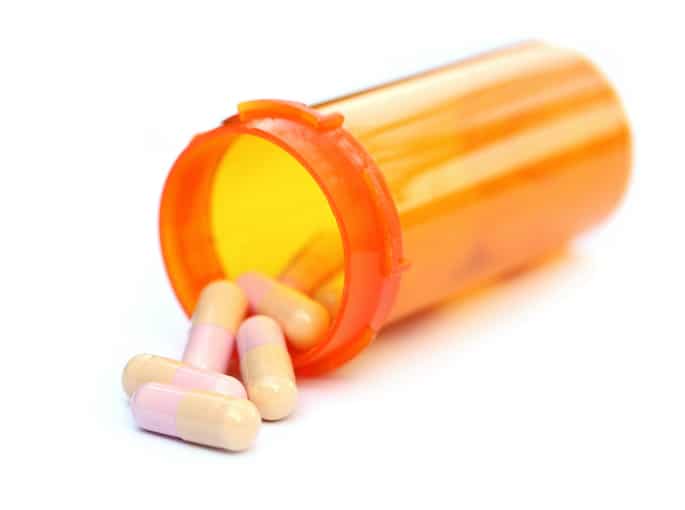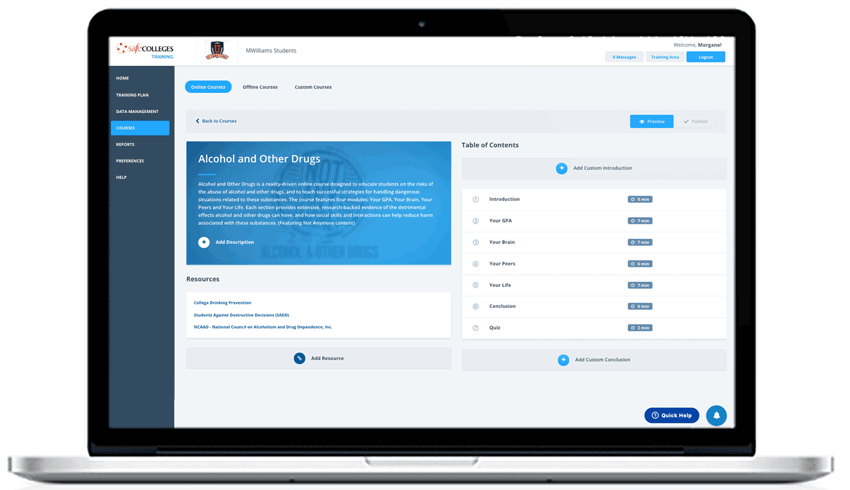About Substance Abuse
Substance abuse is quickly becoming an epidemic on college campuses, regardless of size or geographical location. In the US, one person dies every 19 minutes from a drug overdose.
Typically, students fall into the age group (18-24) that are at a heightened risk for addiction. And, as they make their way on to campus they can suffer from social anxiety or a variety of factors that make drugs, specifically prescription drugs, attractive.
The Addiction Center attributes the following factors to student substance abuse:
- Stress
- Course Load
- Curiosity
- Peer Pressure

Key Focus Areas for Reducing Substance Abuse
Substance Abuse Facts
Substance Definitions
Commonly Abused Drugs
Prevention Education
Substance Abuse Terminology
To fully understand substance abuse and how to reduce the abuse on your campus, it’s important to make sure campus officials are well aware of the terminology used.
Opioids - a class of drugs that include the illegal drug heroin, synthetic opioids such as fentanyl, and pain relievers available legally by prescription, such as oxycodone, hydrocodone, codeine, morphine, and many others.
Depressants - medicines that include sedatives, tranquilizers, and hypnotics. These drugs can slow brain activity, making them useful for treating anxiety, panic, acute stress reactions, and sleep disorders.
Stimulants - medicines generally used to treat attention-deficit hyperactivity disorder (ADHD) and narcolepsy - uncontrollable episodes of deep sleep. They increase alertness, attention, and energy.
Drug Abuse - the use of illegal drugs or the use of prescription or over-the-counter drugs for purposes other than those for which they are meant to be used, or in large amounts. Drug abuse may lead to social, physical, emotional, and job-related problems.
Stimulants Also Known as "Study Drugs"
Study Drugs are prescription stimulants that are abused in order to increase energy and concentration. Adderall, Ritalin, and Vyvanse are the most commonly abused.
Those who haven’t been medically diagnosed with ADHD, or a disorder that these drugs benefit, often list academic pressures, energy fulfillment, and weight loss as the most common reasons for abusing these prescription drugs.
The normalization of selling, distributing, and abusing study drugs seems to be increasing at a rapid rate – students don’t even blink an eye when swapping stimulants with friends or classmates.
Those who sell or distribute these drugs don’t realize the severe consequences they risk – these exchanges can land them in court or in front of a school disciplinary board. While those abusing study drugs don’t factor in any of the significant health issues that may come from ingesting any of these pills.
The health risks, which are often minimized, related to abusing “study drugs” can lead to death as non-prescribed students aren’t monitored or evaluated by a doctor – who can adjust or reduce the dosage. Common side effects associated with these drugs are insomnia, anxiety and depression, cardiac arrest, and hallucinations.
Make sure to learn more about our Prescription Addiction: Stimulants and Depressants course and see how it can help change your students' behaviors with substance abuse.
Depressants Also Known as "Downers"
Depressants work by reducing the amount of stimulation within a person’s central nervous system and is used for mental health illnesses, such as anxiety, sleeping problems, panic attacks, pain relief, stress, and more. This type of prescription drug is highly addictive and responsible for claiming the lives of 38,000 Americans in recent years.
Unfortunately, there has been a 450% increase in the proportion of students who abuse depressants, such as Xanax and Valium. And, it’s often paired with alcohol – creating a deadly combination that can result in dangerous decision making and/or death.
These are some of the long list of high addition-risk depressants:
- Xanax
- Valium
- Klonopin
- Ativan
- Librium

Students abusing depressants may suffer from some unpleasant side effects, such as sweating, irritability, slurred speech, confusion, breathing problems, coma, and more.
Make sure to learn more about our Prescription Addiction: Stimulants and Depressants course and see how it can help change your students' behaviors with substance abuse.
Marijuana
Marijuana, sometimes called weed, dope, and pot, is made up of dried flowers and leaves of cannabis. It contains mind-altering compounds like tetrahydrocannabinol, also known as THC, and other non mind-altering compounds like cannabidiol, also known as CBD. It can be categorized as a depressant, stimulant, or a hallucinogen.
It is the most widely-used illegal drug on college and university campuses - one in every 22 students uses marijuana daily and studies show that it remains at the highest level in the past three decades. And, with evolving technology, students can more easily use marijuana in the open without detection through vaporizers and edible-forms.
The brain is still growing in the early 20s, and heavy use can be highly detrimental to cognitive functioning and mental health. In fact, only 27% of college-aged students perceive regular use of marijuana as carrying great risk of harm. And, it has correlated with poor academic performance and dropping out of college.
Even though it's still considered a Schedule I Controlled Substance under Federal Law, many states have made recreational use of it legal, which has been causing a headache for institutions for higher education within those states.
Make sure to learn more about our Marijuana: What You Should Know course and see how it can help change your students' behaviors with substance abuse.
Opioids
In October 26, 2017, the U.S. government declared a Public Health Emergency to immediately combat the opioid epidemic. In 2016 alone, an average of 116 Americans died every day from opioid-related drugs.
According to the White House, opioid-related deaths are the leading cause of death in the U.S. as it surpassed death by car accidents and gun violence. It’s continuing to cripple communities throughout the country and it’s predicted that more than two million Americans will struggle with an opioid addiction in 2018
According to the U.S. Department of Health and Human Services, 80% of heroin users admit to misusing opioids prior to heroin, meaning opioid abuse can escalate quickly if it goes untreated. This finding emphasizes the importance that campuses should have prevention and wellness programs available to students to help prevent or deal with opioid addiction.
In fact, some states are passing legislation to fight to ensure students have as many addiction prevention resources available to them as possible. For example, Maryland is a state that legally requires higher education institutions, as well as institutions at all levels, to educate students on opioids. It focuses many of its efforts on reoccurring education throughout a student’s time in school.
Also, Maryland requires schools to stock up on Naloxone – the life-saving drug used to reverse the overdosing effects of opioids.
Make sure to learn more about our Prescription Addiction: Opioids course and see how it can help change your students' behaviors with substance abuse.
Here’s How Vector Solutions Can Help
Vector Solutions offers a variety of Alcohol and Drug Abuse Prevention courses for students. These courses can help with prevention and awareness efforts on your campus, specifically with substance abuse. Our reality-based and effective courses feature peer presenters, real-life student testimonials, and awareness and prevention strategies to help change student behaviors on your campus. Below is a list of our courses:

- Alcohol and Other Drugs
- Alcohol and Other Drugs (Refresher)
- Alcohol and Other Drugs - Sanctions
- Marijuana: What You Should Know
- Prescription Addiction: Opioids
- Prescription Addiction: Stimulants and Depressants




